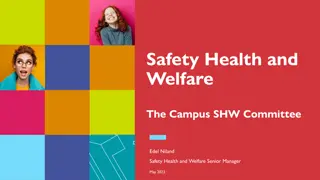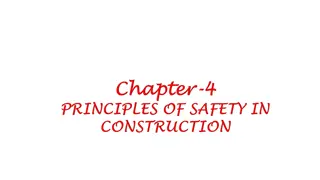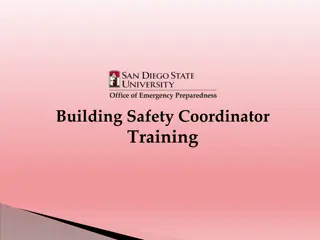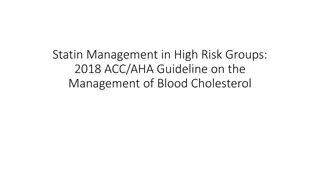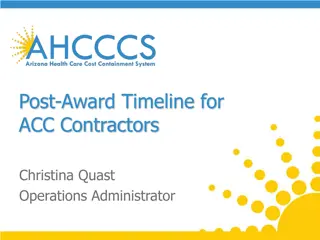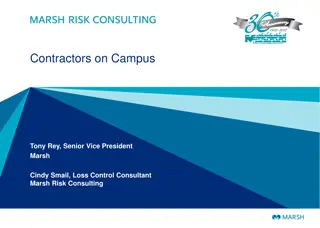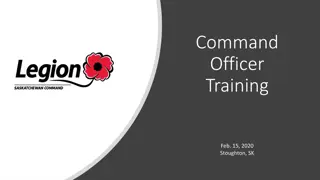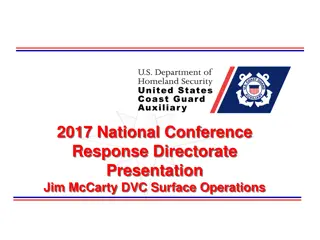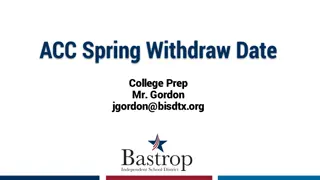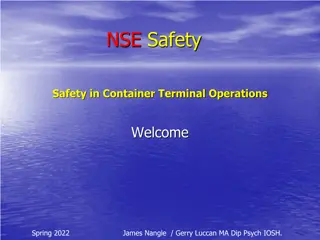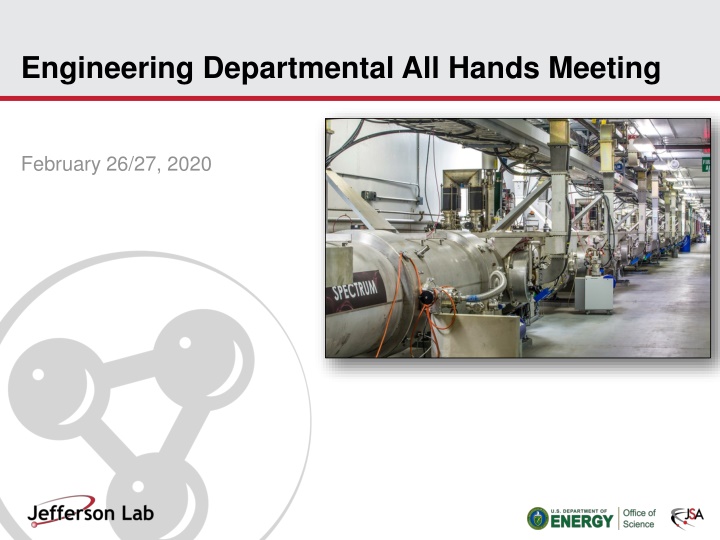
Engineering Departmental All Hands Meeting Safety Review
Discussing recent safety issues, violations, and incidents at the Engineering Departmental All Hands Meeting. Emphasis on the importance of safety, mitigating trends, and perspectives from key individuals. Review of accelerator access violations and overview of recent events.
Download Presentation

Please find below an Image/Link to download the presentation.
The content on the website is provided AS IS for your information and personal use only. It may not be sold, licensed, or shared on other websites without obtaining consent from the author. If you encounter any issues during the download, it is possible that the publisher has removed the file from their server.
You are allowed to download the files provided on this website for personal or commercial use, subject to the condition that they are used lawfully. All files are the property of their respective owners.
The content on the website is provided AS IS for your information and personal use only. It may not be sold, licensed, or shared on other websites without obtaining consent from the author.
E N D
Presentation Transcript
Engineering Departmental All Hands Meeting February 26/27, 2020
Purpose In Coordination with Accelerator Division Why we are here today - Increased number of safety issues. In the last 2 months: Three violations of tunnel access control Electrical shock 120V LERF administrative controls violation What went right - Immediate self reporting thank you This helps to enhance our Reporting Culture and Just Culture the ingredients of Operational Excellence - Prompt action by Director of Accelerator Operations that prioritized understanding administrative controls violation over operations good job The purpose of today s meeting discuss the issues and their common themes, discuss how we can mitigate the trends 2
Importance Safety is number one priority always Previous safety incidents in the lab - Summer 2019 electrical shock, laser near miss - Office of Enforcement finishing investigation and report - A Consent Order will be signed, to follow on OoE actions Most recent cluster of several safety issues - On top of OoE investigation, aggravate the situation - Diminish the confidence of DOE that the lab is getting safety situation under control Similar trends in other labs in the past - Resulted in shut-down of all work for a large fraction of a year 3
Next Department Heads Details on recent safety issues Steven Hoey Perspectives from the new ES&H Director Some Observations from Will Open Discussion 4
Overview of Recent Events 3 Accelerator Access violations No reportable exposure Hall A Access w/o a Radiation Survey/Escort North LINAC Access w/o a Radiation Survey/Escort South LINAC Access w/o a Radiation Survey/Escort LERF Accelerator left unattended No injury, violation, or exposure SRF Shock event No serious injury SRF Knee Injury No Serious Injury 5
Accelerator Access Violation 1 Hall A w/o a Radiation Survey/Escort What Happened: Personnel accessed Hall A labyrinth several times to repair a software crate after beam delivery to Hall No survey was performed prior to nor RCT/ARM escort used 10 CFR 835 protocols require a full or an escorted survey of any enclosure which received beam, regardless of location What Went Right Quick investigation into issue New access protocols put in place to prevent recurrence What Went Wrong Judgement made thinking no exposure danger to access personnel due to location, but This judgement was in conflict with program requirements 6
Accelerator Access Violation 2 NL w/o a Radiation Survey/Escort What Happened: Personnel accessed North LINAC to assist with SRF tasks Full survey was not performed prior to, nor RCT/ARM escort used 10 CFR 835 protocols require a full or an escorted survey of any enclosure which received beam, regardless of location What Went Right Entrant immediately contact MCC upon realizing something wasn t right (expected personnel not present) What Went Wrong Error made Entrant had wrong location due to distraction Error made Entrant given access during multiple access entries Error made Procedure was not followed 7
Accelerator Access Violation 3 SL w/o a Radiation Survey/Escort What Happened: Personnel accessed South LINAC to fix access camera Escorted survey underway 10 CFR 835 protocols require a full or an escorted survey of any enclosure which received beam, regardless of location What Went Right RCT personnel immediately contacted MCC SSO used questioning attitude What Went Wrong Entrant given access during multiple entries Escort was not contacted to request permission to allow access New access protocols were not followed Judgement made thinking no exposure danger to access personnel due to location and history, but This judgement was in conflict with program requirements 8
LERF Accelerator left Unattended What Happened: Issue with a magnet trim card during beam operations No trim cards located within LERF to replace faulty card Personnel secured beam by closing a laser shutter Current Operations Directives require dropping the PSS State before last beam operator leaves the LERF Accelerator building What Went Right Once error was realized, beam operation was ceased Chain of Command immediately contacted Beam authorization rescinded and LERF brought to safe condition What Went Wrong Judgement made based on incorrect rule applied to LERF (loss of situational awareness) 9
Staff Shocked by Hidden Power Source What Happened: Worker was performing property validation Worker inadvertently disconnected power to low voltage equipment during inspection of property Worker came in contact with adjacent and hidden power source What Went Right Worker immediately contacted local Safety Warden Worker contacted Supervisor shortly afterwards Coworker escorted worker to OccMed for medical evaluation What Went Wrong Power source replaced with different source containing high voltage without communicating change to all stakeholders Workmanship of power connections Less Than Adequate Judgement made by worker to place hand into hidden area based on incorrect assumption that no hazard could be present 10
Staff Injured during Non-routine Task What Happened: Worker contacted by coworker to assist with PPE replenishment in specialized area, and injured knee doing this Worker interrupted what they were doing to assist coworker What Went Right Worker helped coworker (worker was one of few trained individuals available to assist) Worker immediately contacted supervisor Coworker escorted worker to OccMed for medical evaluation What Went Wrong Judgement made based on shortcutting area requirements Worker was distracted and had loss of situational awareness 11
Commonalities During the investigation process for each event, several common factors became apparent Loss of Focus by a worker (directly involved or indirectly involved) Loss of situational awareness Perceived time pressure related to task at hand Not questioning: What s the worst that could happen and how can it happen here? Loss of professionalism* (directly involved or indirectly involved) *See next slide for definition 12
Worker Professionalism What does this mean? Doing the job right the first time Planning enough time to complete the job completely Define the scope of the work Understand the hazards involved Place barriers between workers and the hazards Work the plan Reassess everything when the plan changes Clean up after the job is over Feedback what went right and what needs improvement before next task Letting supervisor know when there is not enough time to do the job professionally What s the last job you rushed or didn t complete completely? What prevented you from completing it? What could we, as an organization, do differently? How could we, as an organization, set you up for success? 13
Steven A. Hoey Director ESH JLab
Background Experience: 29 Years National Laboratory in ESH (INEL and BNL) Aerospace (Space Shuttle and B1B bomber) Chemical processing (highly toxic materials HCN) 15
Observations What have I learned the past few weeks? Dedicated staff Strong culture of mission success Robust controls/processes in place What have I seen the past few weeks? Three incidents (electrical shock, access control, LERF control) Incidents are repetitive Overall sense of too much to do (everyone is very busy) JSA Review track plans of action on most recent events, assessment of lab management actions to ensure corrective actions are impactful and aligned insuring safe and effective operations across the laboratory Office of Enforcement Conference uncertain outcome 16
Events have Consequences NREL January 2020 - Two Shock incidents, (lab built and commercial) influenced OE look at broader programmatic deficiencies Sandia August 2019 - Electrical arc, no injuries, started fire ANL 2017 - Two Electrical shock incidents - Lab shutdown for 7 days BNL 2012 - Linac Beam mis steering event - NSLS-II commissioning delayed 3-4 months SLAC 2004 - Arc flash incident - Accelerator shut down for over 6+ months 17
World Class Science Requires World Class Safety Current State TJNAF safety performance is statistically similar to SC Labs, but too many close calls Recurring problems highlight past failures to isolate and treat root cause Human Performance Improvement practices taking hold too slowly Restoring a Robust Safety Culture Major FY20 investments in: - Expanding event investigation process, stood up a separate Performance Assurance Office - Reengineered task hazard analysis process oriented to explicitly help workers do their jobs - Expanding safety training to include skills demonstration - Increasing our commitment to engineered controls to reduce reliance on administrative controls - Expanding supervisor responsibilities for worker engagement and oversight Integrating Lab Agenda Initiatives into a comprehensive, multi-year Operational Excellence Plan Explicit subcontractor safety requirements and selection process TJNAF SC Labs TRC DART 18
Observations Path Forward Restore DOE s confidence that we can operate this lab safely and meet our mission goals Learn from incidents to make sure we understand root causes and develop meaning full and effective corrective actions prevent repetition Develop a Culture of Prevention get away from Culture of Reaction Stop and think before we do work what are the hazards and consequences Everyone needs to participate in this stand down and ongoing corrective action plans initiatives to prevent incidents Need to stop hurting people engage and use HPI concepts 19
Worker Professionalism What does this mean here and at home? Doing the job right the first time like you were paying for it Produce a product you will be proud of which means: Define the scope of the work Planning enough time to complete the job completely (Let your supervisor know when there is not enough time to do the job professionally Work the plan Reassess everything when the plan changes Have someone check your work Clean up after the job is over When appropriate, document what you did Above all stay safe throughout At JLab what s the last job you rushed or didn t complete thoroughly? What prevented you from completing it? What could we, as an organization, do differently? How could we, as an organization, set you up for success? I want to hear from you on the 3 above questions, discuss at your toolbox meetings & e-mail comments! 21
Discussion and Stand-Down plans After this All Hands and for remaining time of Stand-Down: - Safety related activities coordinated by Department Leads Now open for discussion 22


